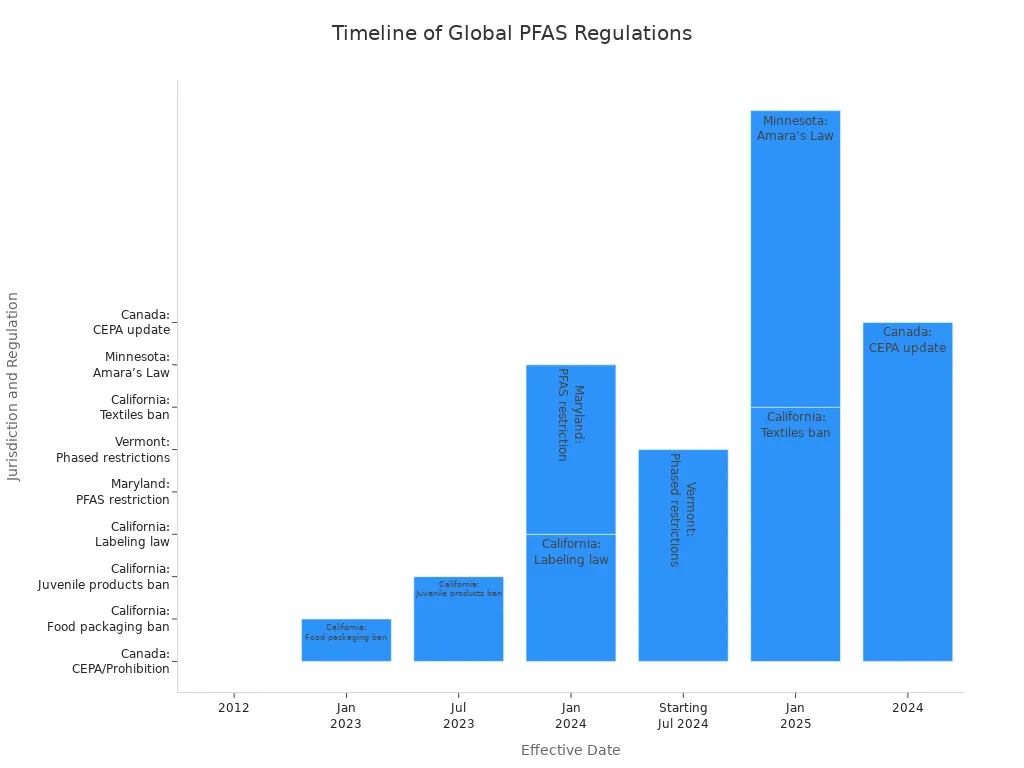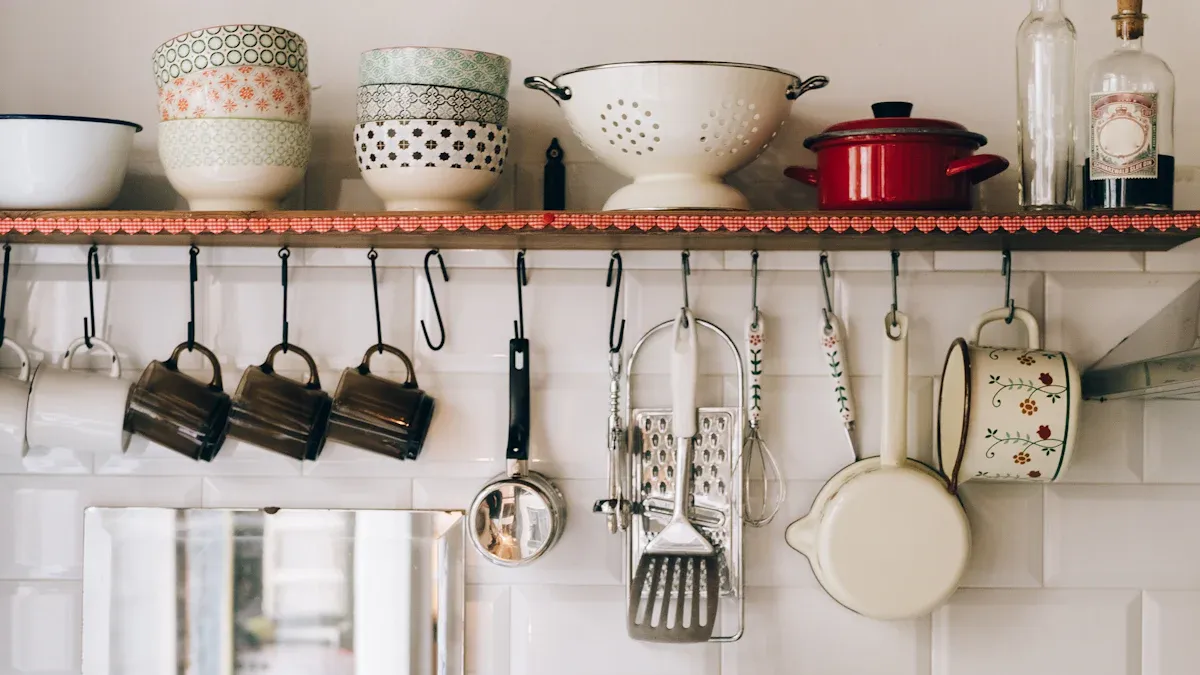
You want a healthier kitchen for your growing families. PFOA in non stick cookware set can harm your health. PFOA-free cookware helps you create a toxin-free kitchen. Choose a non stick cookware set labeled pfoa free. Nonstick cookware and non-stick cookware with pfoa-free cookware keeps families safe. Non-toxic cookware offers non-toxic, nonstick, and non-stick benefits.
PFOA-free cookware supports non-toxic, nonstick cooking for better health.
Understanding PFOA and Its Impact on Health
What Is PFOA in Non Stick Cookware Sets?
You may have heard about PFOA when shopping for nonstick pans. PFOA stands for perfluorooctanoic acid. It belongs to a group of chemicals called forever chemicals because they do not break down easily in the environment or your body. Manufacturers once used PFOA as a processing aid to make PTFE, the slippery coating that gives nonstick cookware its easy-release surface. PFOA is not the nonstick coating itself, but it helped create it. Because of health concerns, companies have phased out PFOA in cookware made after 2015.
Here is a table to help you understand PFOA’s role in nonstick cookware:
| Aspect | Description |
|---|---|
| Chemical Structure | PFOA (Perfluorooctanoic acid) is a synthetic chemical from the PFAS family characterized by an 8-carbon fully fluorinated chain with a carboxylic acid group. |
| Function in Cookware Manufacturing | PFOA is used as a processing aid in the production of PTFE (Polytetrafluoroethylene), which is the actual non-stick coating applied to cookware. It imparts oil, water, and stain repellency during the manufacturing process but is not the coating itself. |
| Additional Notes | PFOA has been phased out due to health and environmental concerns, as it is persistent in the environment and linked to health risks. New cookware alternatives are PFOA-free. |
Before 2015, most nonstick cookware contained PFOA. The EPA’s Stewardship Program pushed manufacturers to remove PFOA from their products. Today, you can find pfoa free and pfoa-free cookware sets in stores. However, some imported pans may still contain PFOA, so always check labels for pfoa free claims.
Tip: If you want to avoid forever chemicals in your kitchen, choose cookware labeled as pfoa free or pfoa-free cookware.
Health Risks of PFOA Exposure for Families
PFOA can cause serious health effects for you and your loved ones. Scientists call PFOA a forever chemical because it stays in your body for years. Even small amounts can build up over time. Studies show that pfoa exposure can harm children and adults in many ways.
- Reviews of scientific research show that early-life exposure to PFOA and other forever chemicals can affect brain development. These chemicals can cross the placenta and enter breastmilk, exposing babies during important growth periods. Expecting parents should know that these exposures may lead to learning and behavior problems in children.
- A study found that children exposed to a mix of forever chemicals, including PFOA, had a higher risk of developing leukemia. This shows a link between pfoa and cancer in children.
- Other research found that PFOA exposure can weaken the immune system. Children exposed to PFOA may have a lower response to vaccines and a higher risk of infections, allergies, asthma, and skin problems.
The health implications of long-term PFOA exposure include:
- Reproductive problems, such as lower fertility and high blood pressure during pregnancy
- Developmental delays in children, including low birth weight and behavior changes
- Increased risk of cancers like kidney and testicular cancer
- Weakened immune system and lower vaccine response
- Hormone disruption
- Higher cholesterol and risk of obesity
- Liver damage and thyroid disease
Expecting parents and families should pay close attention to these health effects. Choosing pfoa-free cookware helps protect your family from these toxins and health concerns.
How PFOA Exposure Happens at Home
You can come into contact with PFOA in your kitchen in several ways. The most common sources are older nonstick pans, contaminated food, and drinking water. Forever chemicals like PFOA can also collect in house dust. When you cook with nonstick pans made before 2015, heating them at high temperatures can release PFOA fumes into the air. These fumes can cause flu-like symptoms in people and can be deadly to pet birds.
- Cooking on high heat with old nonstick pans can release PFOA into your food and indoor air.
- Scratching or damaging the nonstick coating increases the release of forever chemicals into your meals.
- Using steel wool or metal utensils can damage the coating and make it easier for toxins to get into your food.
- House dust can pick up PFOA from cookware, food packaging, and other products. You can breathe in or swallow this dust, especially if you have young children at home.
Note: To reduce pfoa exposure, use pfoa-free cookware, cook on medium or low heat, and avoid using damaged nonstick pans.

Many countries and states now require clear labeling of pfoa free cookware and ban the use of forever chemicals in new products. This global trend helps keep families safe from the health risks of PFOA and other toxins.
Choosing PFOA-Free Cookware and Safer Alternatives

How to Identify PFOA-Free Cookware
You want to make sure your non stick cookware set is truly pfoa free. Look for clear labels and trusted certifications. Reliable ways to identify pfoa-free cookware include:
- California’s Prop 65 compliance, which means the cookware meets strict safety standards for toxic substances.
- FDA approval, showing the materials are safe for food contact.
- Labels that state the cookware is PFAS-, PFOA-, and PTFE-free.
- Third-party lab testing, which gives independent proof of non-toxic cookware claims.
You should also check the product description for “pfoa free” or “pfoa-free cookware.” Buy from reputable brands that share details about their manufacturing process. If you feel unsure, contact the manufacturer for proof. Remember, many people think “pfoa free” means the cookware is also PTFE-free, but this is not always true. Some nonstick cookware still uses PTFE in the coating.
Benefits of PFOA-Free Non Stick Cookware Sets
Switching to pfoa-free cookware brings many health benefits for your family. You lower your exposure to harmful chemicals that can leach into food. This helps reduce the risk of hormone problems, thyroid disorders, and liver damage. Families using pfoa-free nonstick cookware see improved immune system function and fewer reproductive health issues. You also lower the risk of certain cancers. Choosing a non stick cookware set that is pfoa free creates a safer cooking environment and supports safe meals.
Tip: PFOA-free non stick cookware sets help you prepare food with less worry about toxins, making your kitchen a healthier place.
Safer Alternatives: Ceramic, Stainless Steel, and Cast Iron
You have several options for quality non-toxic cookware. Ceramic cookware is naturally nonstick at low and medium heat. It is non-toxic if labeled lead and cadmium-free. Cast iron is durable, becomes nonstick when seasoned, and may add healthy iron to your food. Stainless steel is another safe cookware choice. High-quality cookware made from stainless steel is non-toxic and safe for most people. These materials do not use pfoa or other PFAS chemicals in their coating. They help you avoid the health risks linked to traditional non-stick cookware.
| Cookware Type | Nonstick Performance | Durability | Health and Safety |
|---|---|---|---|
| Ceramic | Good, needs some oil | Prone to chipping | Non-toxic, PFOA-free |
| Cast Iron | Naturally nonstick | Very durable | Adds iron, non-toxic |
| Stainless Steel | Needs oil | Very durable | Non-toxic, safe coating |
Choose high-quality non-toxic cookware to protect your family’s health and enjoy safe meals every day.
You protect your family’s health when you choose cookware labeled pfoa free. Many families switch because of health risks from pfoa, environmental concerns, and a desire for safer cooking.
- Pfoa exposure links to hormone disruption, cancer, and immune issues.
- Pfoa-free cookware reduces pollution and chemical contamination.
- Some pfoa-free pans still contain PTFE, so check for trusted certifications.
- Safer alternatives like ceramic, stainless steel, or cast iron do not use pfoa or other PFAS.
Experts recommend you avoid cookware with pfoa and always verify safety claims to prevent regrettable substitution.
You create a safer kitchen by choosing truly pfoa-free cookware and maintaining it well.
FAQ
What does “PFOA-free” mean on cookware labels?
You see “PFOA-free” on cookware labels. This means the manufacturer did not use PFOA chemicals when making the nonstick coating.
Can PFOA-free cookware still contain other harmful chemicals?
You should check for PFAS-, PTFE-, and lead-free labels. Some PFOA-free pans may still use other chemicals. Always read the product description.
How do you care for PFOA-free nonstick cookware?
- Wash with a soft sponge.
- Avoid metal utensils.
- Cook on low or medium heat.
- Store pans carefully to protect the coating.


